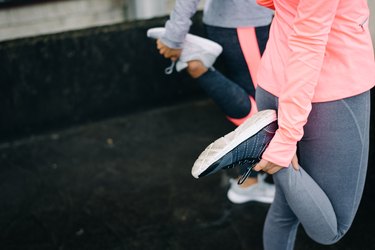
Exercise might not be the best way to get rid of inflammation in the knee, but it may help. It's particularly beneficial for those with arthritis, leading to greater flexibility and range of motion. Certain movements can also strengthen the muscles surrounding your knee and relieve discomfort.
What Causes a Swollen Knee?
Video of the Day
Knee inflammation can have a multitude of causes, from osteoarthritis to overuse injuries and bursitis. This symptom results from fluid on the knee joint, explains the Mayo Clinic. Most times, it's accompanied by pain, swelling and limited range of motion.
Video of the Day
As the Mayo Clinic notes, damage to any part of the knee may cause inflammation. Sometimes, this issue is due to a torn ligament. Other times it may indicate an underlying condition, such as rheumatoid arthritis.
Meniscal injuries, for example, cause swelling 24 to 36 hours after the incident, according to a July 2013 review featured in the Journal of the Royal Society of Medicine. Another common cause is prepatellar bursitis, an inflammatory condition of the knee. In this case, you may experience pain when moving around and rapid swelling on the front of your kneecap.
Read more: Swelling of the Knee After Exercise
Knee inflammation can also be a sign of osteoarthritis, a chronic disease affecting more than 30 million Americans. This chronic disorder can damage any joint, especially the knee, reports Harvard Health Publishing. Over time, it may cause pain and swelling, limiting your ability to move around and perform everyday tasks.
Depending on the cause of your symptoms, knee inflammation treatment may include physical therapy. Low-impact activities like walking, swimming and water aerobics may help too, notes Harvard Health Publishing. A good exercise for knee inflammation can be cycling or riding an elliptical trainer. The key is to start slowly and listen to your body.
Best Exercise for Knee Inflammation
Exercise may or may not relieve knee pain and inflammation. In some cases, it could worsen your symptoms. That's why it's better to seek medical help. A physiotherapist can determine the root cause of knee inflammation and develop an exercise plan tailored to your needs.
Knee osteoarthritis, for instance, responds well to exercise, according to an October 2013 research paper in Open Access Rheumatology: Research and Reviews. Therapeutic exercise is often the first line of treatment for this condition and may help decrease inflammation. Certain movements, especially those that apply a dynamic load to the knee joint, may reduce excessive joint compression and ease the pain.
A review published in the journal PM&R in May 2012 suggests that resistance training may improve joint mechanics and muscle strength. Squats, lunges, step-ups and leg extensions are just a few examples.
Read more: Bad Knees? Try These 14 Knee-Strengthening Exercises
However, you may not be able to move your knee as usual, especially when you're in pain. Some exercises should be modified according to your needs. Researchers recommend using light weights and keeping your routine varied. Get at least 24 hours of rest between training sessions too.
Prevention Is Your Best Defense
Regular exercise may also protect against knee injuries by strengthening the muscles in this area, states the American Academy of Orthopaedic Surgeons. For example, you can do straight leg lifts, wall squats or hamstring curls from a standing position. Stretching the quads and hamstrings is just as beneficial. Here are some stretches you can try right now:
Move 1: Hamstring Stretch
- Sit on the floor with the legs extended and your palms on the floor. Keep your feet neutral.
- Slide your hands on the floor toward your ankles, bending at your hips. Look straight ahead and don't arch your back.
- Continue until you feel the stretch in your hamstrings. Hold for about 30 seconds and repeat.
Move 2: Quadriceps Stretch
- Stand up facing a wall. Rest your right hand on it for support. Keep your knees close together and your back straight.
- Lift your left foot toward your buttocks, grasping the ankle with your left hand.
- Bring your heel to your buttocks. Hold for 30 seconds and repeat.
- Do the same on the right side.
Again, it's important to listen to your body. If, say, you can't do full squats because your knee hurts, try a partial squat and place your hands on a wall for support. Consider using resistance bands instead of gym machines for leg extensions. Avoid high-impact movements, such as jumping, as they may increase the stress on your knee joints.
There is no specific exercise for knee inflammation. Generally, it's recommended to perform gentle movements that stretch and strengthen the muscles around your knee. Depending on your symptoms, consider reaching out to a doctor or physical therapist before getting started. If you have a knee injury, squats and other exercises may worsen the pain.
- Mayo Clinic: "Swollen Knee"
- Journal of the Royal Society of Medicine: "The Acute Swollen Knee: Diagnosis and Management"
- American Academy of Orthopaedic Surgeons: "Prepatellar (Kneecap) Bursitis"
- Harvard Health Publishing: "Moving Away From Knee Osteoarthritis"
- Open Access Rheumatology: Research and Reviews: "The Pain-Relieving Qualities of Exercise in Knee Osteoarthritis"
- PM&R: "Resistance Exercise for Knee Osteoarthritis"
- American Academy of Orthopaedic Surgeons: "Knee Exercises"
Was this article helpful?
150 Characters Max
0/150
Thank you for sharing!
Thank you for your feedback!